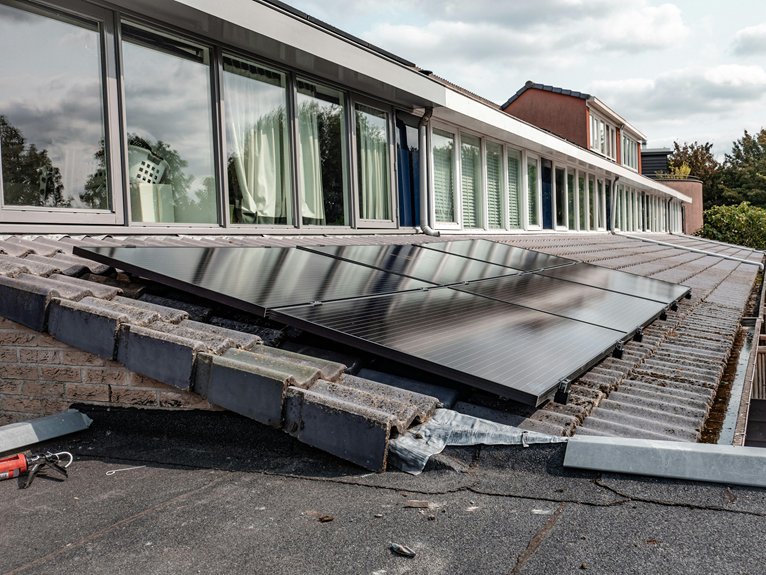If you’re considering solar panels in Oklahoma City, ensuring your roof can support them is essential. The age, material, and overall condition of your roof play a significant role in determining compatibility. Ignoring these factors could lead to costly repairs or premature system failure. Understanding when to replace or repair your roof before installing solar panels can save time and money in the long run. Here’s what you need to know to make an informed decision.
Assessing Your Roof’s Age and Condition
Before installing solar panels, it’s essential to evaluate your roof’s age and overall condition. Check how old your roof is—most solar companies recommend replacing a roof if it’s over 20-25 years old.
Look for signs of damage, such as missing shingles, cracks, or leaks. A sturdy, well-maintained roof can support solar panels reliably.
If your roof shows wear or has reached the end of its lifespan, consider replacing it before installation. This prevents the need to remove panels later, saving you time and money.
Ensuring your roof is in good shape now helps maximize your solar investment and protect your home.
For professional advice and assistance, you can request a free inspection to assess your roof’s condition before proceeding.
Understanding Oklahoma City’s Climate and Its Impact on Roofs
Oklahoma City’s climate plays a significant role in how well your roof can handle solar panels. The area experiences hot summers, cold winters, and occasional severe storms, which can strain roofing materials.
Frequent temperature fluctuations cause expansion and contraction, potentially leading to wear and tear. Heavy hail can damage roofing surfaces, making durability a key concern. Wind storms may also loosen or uplift sections of your roof.
Understanding these climate effects helps you choose a resilient roof that supports solar installation long-term. Properly assessing your roof’s ability to withstand Oklahoma’s weather ensures your solar panels remain secure and functional for years to come.
Key Roofing Materials Suitable for Solar Installation
Choosing the right roofing material is essential for guaranteeing your solar panels remain secure and perform efficiently. Metal roofs, such as standing seam and corrugated steel, are ideal because they’re durable, lightweight, and easy to mount without risking damage.
Asphalt shingles are common and compatible with most solar systems, but make certain they’re in good condition.
Concrete and clay tiles can support solar panels but require specialized mounting hardware to prevent cracks.
Avoid membranes like EPDM or TPO, as they’re not suitable for mounting.
Selecting durable, stable materials assures your solar investment is protected and maximizes energy output over time.
Identifying Structural Requirements for Solar Panel Support
To guarantee your solar panels are properly supported, you need to accurately assess your roof’s structural integrity. Start by inspecting the existing framing and load-bearing components. Check for signs of damage, rot, or deterioration that could weaken support.
Confirm that your roof can handle the added weight of the panels and mounting hardware. Consult a structural engineer if necessary to evaluate load capacity and ensure compliance with local building codes.
Reinforcing weak areas before installation can prevent future issues. Proper assessment ensures your roof can safely hold the solar system, avoiding costly repairs or safety hazards down the line.
Recognizing Signs That Indicate Roof Repairs or Replacement Needed
Identifying the need for roof repairs or replacement is essential before installing solar panels, as hidden damage can jeopardize your system’s safety and longevity. Look for visible signs like curling, cracking, or missing shingles, which indicate wear.
Water stains or leaks inside your home suggest underlying damage. Check for sagging areas or uneven surfaces that may weaken the structure. Excessive granule loss from shingles or algae growth also signals deterioration.
If your roof is over 15-20 years old or has experienced severe weather, it’s wise to have a professional inspection. Addressing these signs early ensures your roof can support solar panels safely and effectively.
Timing Your Roof Replacement for Optimal Solar Panel Installation
Timing your roof replacement correctly can make a significant difference when installing solar panels. Ideally, you should schedule your roof replacement before installing solar panels to ensure a solid, durable surface.
Waiting until after installation risks damaging or needing to remove panels later, which can increase costs. Plan your roof replacement during a dry season with good weather, so work progresses smoothly.
Coordinate with your solar installer to determine the best timing, ensuring the new roof is ready before panels go up. Proper timing prevents unnecessary delays or damage, maximizing your investment and ensuring your solar system functions efficiently for years to come.
Working With Professionals to Ensure Compatibility and Longevity
Working with experienced professionals is essential to guarantee your solar panels and new roof work together seamlessly and last for years. They’ll assess your roof’s structure, ensuring it can support the added weight and withstand Oklahoma’s weather conditions.
Professionals will also select compatible roofing materials that won’t compromise your solar system’s efficiency. Proper installation techniques prevent leaks, damage, and premature wear.
By collaborating with experts, you get personalized advice tailored to your home’s specifics. This partnership helps maximize your investment, ensuring your solar panels function ideally for decades, while your roof remains durable and reliable.
Trusting skilled professionals is the best way to achieve long-lasting, harmonious roof and solar panel performance.
Conclusion
Ensuring your roof is ready for solar panels means checking its age, condition, and materials. In Oklahoma City, a sturdy, well-maintained roof is essential for long-lasting solar performance. By working with professionals and timing your replacement wisely, you can maximize your investment and avoid future issues. When your roof is compatible, you’ll enjoy clean energy benefits for years to come without worries about repairs or structural problems. For more information on how to schedule your free roof inspection, call us at (405) 543-2920 or visit us online at Top View Roofing.

